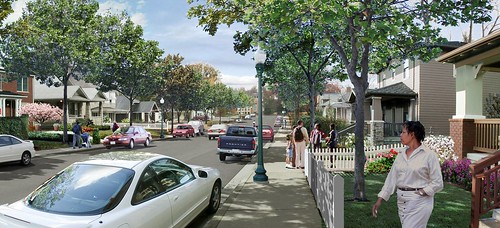Sprawl is slowing, part 2: reducing the footprint of growth

Posted March 26, 2008 at 10:25PM
Wonky, wonky post coming up. Bear with me, it’s worth it.
Just a week after I posted that indicators of smart growth were starting to overtake indicators of sprawl, we’ve got even more numbers, and they are good ones.
First, after some six decades of unchecked population dispersal, all the infill and compact development we have been advocating is starting to pay off. For the most recent year for which we have relevant data (2003), the trend has halted, and we now actually have more people per acre of developed land than we had in the previous data-year (2001). In particular, in 1982, the US had a population density of about 3.2 people per developed acre. That’s not a heck of a lot, to be sure, but it got worse. As we kept sprawling out, by 2003 that fraction had dropped to only 2.67 people per acre.

But in 2003, for the first time, the trend reversed, and our population density actually went up, if only a little, to 2.69 people per acre. Not very much, you’re thinking? My colleague, NRDC analyst Nathan Sandwick, anticipated your query and looked at the marginal increments of development as well as the totals.
From 2001-2003, if you compare the additional increment of population growth to the additional increment of developed land, our new growth developed at a rate of 3.31 people per acre, a significantly more compact pattern.
Let’s look at the numbers a different way: in 2001, for each resident of the US, we had 0.37 acres of developed land. And the way we got there wasn’t pretty, developing at marginal rates of 0.58-0.87 new developed acres per new person from 1982-2001. Yikes. But since then we’ve been developing at a much more encouraging rate of 0.30 acres person. In other words, the footprint of our new growth since 2001 has been smaller than that of our pre-existing development, and much smaller than that of the preceding decades. If the trend holds, we can say that the rate of sprawl has been cut in half. Go here and here for the numbers that Nathan crunched.
 While two years certainly isn’t long enough to confirm a lasting trend, these data are enough to make one hopeful, especially in conjunction with the second thing I have to tell you:
While two years certainly isn’t long enough to confirm a lasting trend, these data are enough to make one hopeful, especially in conjunction with the second thing I have to tell you:
In 2007, for the first time in at least 25 years (that’s how far back our numbers at close hand go), aggregate vehicle miles traveled declined in the US. This is not just driving per capita or the rate of increase going down, this is the absolute amount of driving nationwide. Here are a few of the numbers from the relevant data set:
in Millions of miles
Year Total
1982 1,592,481
1992 2,247,152
2002 2,855,508
2003 2,890,450
2004 2,962,491
2005 2,992,740
2006 3,014,081
2007 3,003,218
Note the increase every year until this one. Now land use is not likely the most important reason for the change, given rising gas prices and a sluggish economy.  But beginning to implement better land use surely helps, and can work to encourage the trend. Moreover, smart growth communities that are walkable and transit-accessible are the ones best positioned to maintain their residents’ quality of life and their businesses' prosperity in a future in which driving is more costly.
But beginning to implement better land use surely helps, and can work to encourage the trend. Moreover, smart growth communities that are walkable and transit-accessible are the ones best positioned to maintain their residents’ quality of life and their businesses' prosperity in a future in which driving is more costly.
Incidentally, these latest numbers on driving came our way via the startlingly named Collision Week, a trade publication aimed, as far as I can tell, at auto body shops. I’m not a regular reader, which I hope doesn’t surprise you, but somehow the article made its way to my NRDC colleague Luke Tonachel. One apparently needs a subscription to access the article directly, but the same numbers may be found on the federal Department of Transportation’s site, here.